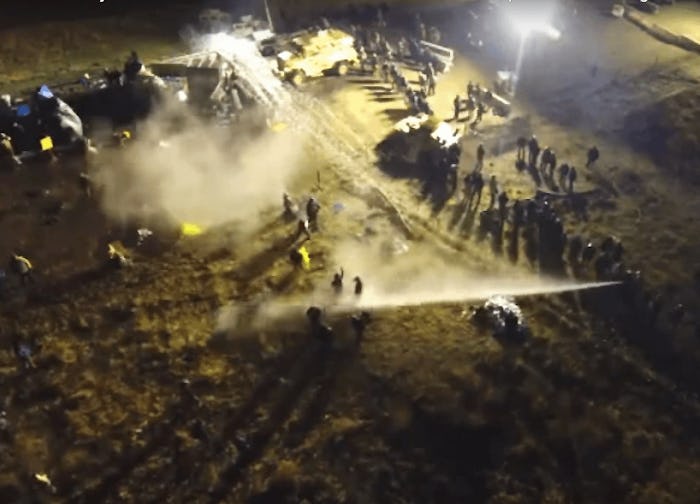News
Did Standing Rock Protesters Become Violent? Police Used Water Cannons & Rubber Bullets
The protests against the Dakota Access Pipeline at Standing Rock Sioux Reservation in North Dakota have entered their eighth month, with protesters gathering both at the site itself, and in solidarity all around the country. On Sunday night, the protests took a turn for the barbaric, as law enforcement officers from the Morton County Sheriff's Department fired tear gas and rubber bullets at more than 400 protesters, in addition to dousing them with water cannons in sub-freezing temperatures. Did the Standing Rock protesters become violent? Like so many other clashes since this protest began back in April, it all depends on who you ask.
The clash — which Morton County law enforcement has called a "riot" — took place along the Backwater Bridge along highway 1806 in Mandan, just north of a protest camp. According to a statement from the Morton County Sheriff's Department, protesters were "very aggressive" and engaged in "tactical movement." A Facebook post by the Sheriff's Department alleged that protesters "started a dozen fires" near Backwater Bridge.
Meanwhile, several protesters at the site who live-streamed footage of the clash between protesters and police told a much different story, alleging that protesters were unarmed and peaceful. Warning: The following videos and images contain disturbing, graphic footage of the Standing Rock protests Sunday night.
Maxine Herr, a spokesperson with the Morton County Public Information Office, told Romper exclusively via phone that, in addition to the fires and attempts to flank a police line, protesters used sling shots to throw rocks at police. According to Herr, an officer was struck in the head by a rock and had to be removed from the line of officers at the scene; the unnamed officer was not taken to the hospital for his or her injury.
Video taken at Standing Rock by another protester, Kevin Gilbert, showed police and the National Guard firing projectiles into a crowd of protesters while also spraying them with water cannons. Speaking to The Guardian, spokeswoman for the Indigenous Environmental Network Jade Begay said that 167 people were injured in the skirmishes with police, seven of whom were taken to the hospital for their injuries.
On Twitter, the Indigenous Environmental Network shared a video of Leland Brenholt, a medic at the Oceti Sakowin protest camp, who talked about protesters' injuries, from hypothermia to rubber bullets and tear gas canisters to the face and head.
The irony of spraying water protectors, as the protesters have been called, with water is certainly not lost on anyone. Further alarmingly, it's almost inconceivable that, with just three days until Thanksgiving — a national holiday meant to celebrate the peace between the colonists and Native Americans, how the Native Americans helped those early Americans survive their first winter — there have been police soaking protesters fighting for the sovereignty of native land with water cannons in freezing temperatures.
